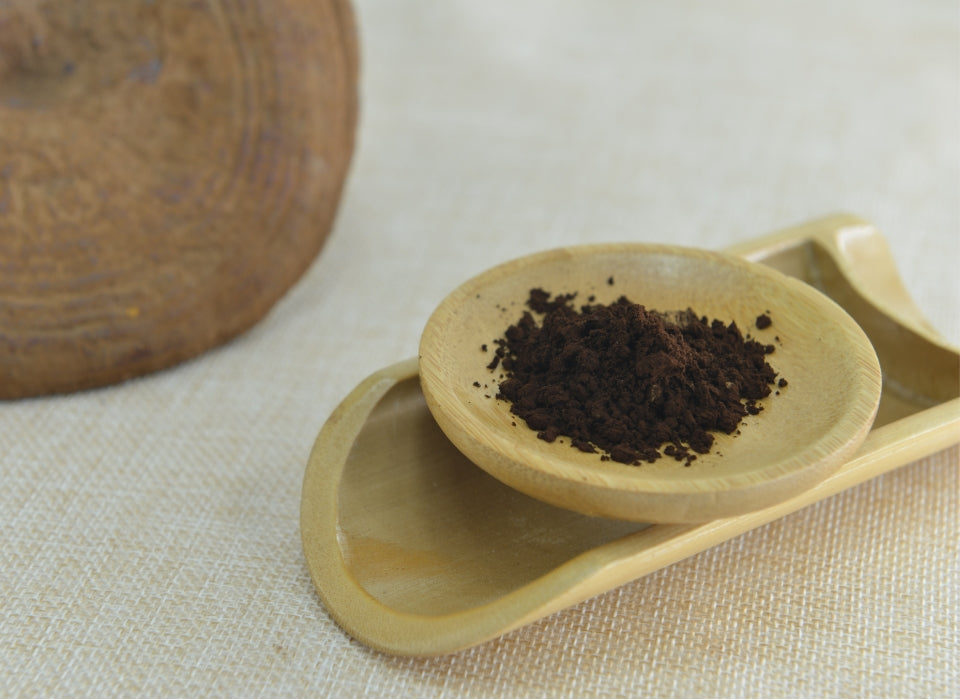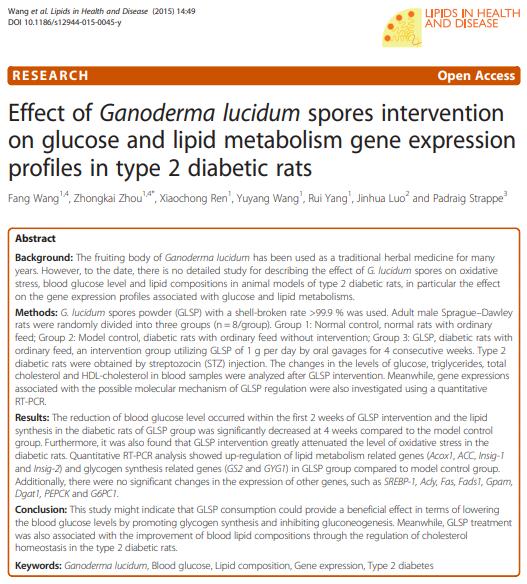
SHELL-BROKEN GLSP IMPROVES GLUCOSE&LIPID IN TYPE 2 DIABETIC RATS
May 22, 2015 / Tianjin University of Science and Technology / Lipids in Health and Disease
Text/Wu Tingyao
There have been many scientific discussions on how Ganoderma lucidum fruiting bodies can improve diabetes, but there are few related studies on the role of Ganoderma lucidum spores in this regard. This report, published in “Lipids in Health and Disease” by Tianjin University of Science and Technology, China, explores the effect of shell-broken Ganoderma lucidum spore powder (GLSP) with a shell-broken rate >99.9% on blood glucose, blood lipids and oxidative stress in type 2 diabetic rats.
The three groups of male rats participating in the experiment are all adults, with 8 rats in each group. Group 1: Normal control, normal rats with ordinary feed; Group 2: Model control, diabetic rats with ordinary feed without intervention; Group 3: GLSP, diabetic rats with ordinary feed, an intervention group utilizing GLSP of 1 g per day by oral gavages for 4 consecutive weeks. In rats, type 2 diabetes results from the destruction of islet cells by injection of Streptozocin.
It was found that the blood glucose of diabetic rats that ate shell-broken Ganoderma lucidum spore powder began to drop from the second week and was 21% lower than that of diabetic rats that did not take Ganoderma lucidum by the end of the fourth week, but it was still four times the blood glucose of normal rats.
In terms of blood lipid compositions, compared with diabetic rats that did not eat the shell-broken Ganoderma lucidum spore powder, the total cholesterol of diabetic rats in the Ganoderma lucidum group was reduced by 49%, and their triglycerides were reduced by 17.8%. However, these indexes of both of them were far away from those of normal rats (their total cholesterol is about five times that of normal rats, and their triglycerides are one and a half times as much.) Only HDL-C, commonly known as “good cholesterol,” rises to levels close to that of normal rats.
Diabetes can significantly increase the oxidative stress in the body, but eating shell-broken Ganoderma lucidum spores for four weeks can significantly reduce the concentration of MDA (malondialdehyde) and ROS (reactive oxygen species) in the blood of diabetic rats. These two values are still higher than those of normal rats, but the two important antioxidant enzymes, GSH-Px (glutathione peroxidase) and SOD (superoxide dismutase) are also higher than those of normal rats, showing that shell-broken Ganoderma lucidum spores can effectively enhance the antioxidant capacity of diabetic rats, thereby alleviating excessive oxidative stress.
Further analysis revealed that several genes related to lipid metabolism (Acox1, ACC, Insig-1 and Insig-2), as well as genes related to glycogen synthesis (GS2 and GYG1), have more expression levels than those diabetic rats who did not eat shell-broken Ganoderma lucidum spores. However, some genes showed no significant differences, including SREBP-1, Acly, Fas, Fads1, Gpam and Dgat1 involved in lipid metabolism, and PEPCK and G6PC1 involved in carbohydrate metabolism.
All in all, although there is still some distance from “returning to normal”, the shell-broken Ganoderma lucidum spore powder has shown its benefits for type 2 diabetes within a month, including lowering blood glucose and blood lipids. From the perspective of gene expression, its mechanism of action may be related to promoting glycogen synthesis, inhibiting gluconeogenesis (inhibiting the conversion of non-carbohydrates into glucose), and regulating the proportion of HDL in cholesterol. As for what active ingredients make the shell-broken Ganoderma lucidum spore powder effective, this paper does not specifically elaborate..
[Source] Wang F, et al. Effect of Ganoderma lucidum spores intervention on glucose and lipid metabolism gene expression profiles in type 2 diabetic rats. Lipids Health Dis. 2015 May 22;14:49. doi: 10.1186/s12944-015-0045-y.
END
About the author/ Ms. Wu Tingyao
Wu Tingyao has been reporting on first-hand Ganoderma information since 1999. She is the author of Healing with Ganoderma (published in The People’s Medical Publishing House in April 2017).
★ This article is published under the exclusive authorization of the author. ★ The above works cannot be reproduced, excerpted or used in other ways without the authorization of the author. ★ For violations of the above statement, the author will pursue relevant legal responsibilities. ★ The original text of this article was written in Chinese by Wu Tingyao and translated into English by Alfred Liu. If there is any discrepancy between the translation (English) and the original (Chinese), the original Chinese shall prevail. If readers have any questions, please contact the original author, Ms. Wu Tingyao.
